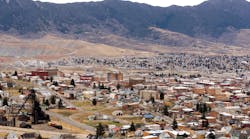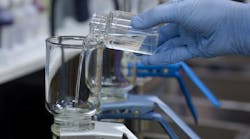Collaborative efforts by the Metropolitan Water Reclamation District of Greater Chicago (MWRD) and downstate agricultural partners to capture nutrients in water are contributing to cleaner waterways locally in the Chicago Area Waterway System and downstream in the Illinois River flowing into the Upper Mississippi River and Gulf of Mexico.
The quality of local and international waters shows signs of progress due to decreased nutrients. For example, the Gulf of Mexico’s oxygen-starved hypoxic area, otherwise known as the “dead zone,” shrank in 2022, according to the National Oceanic & Atmospheric Administration (NOAA).
Excess nutrients, like phosphorus and nitrogen, flowing from water reclamation plants (WRPs), agriculture fields and urban areas can cause algae blooms to grow in waterways, depleting oxygen for fish and other aquatic life. A new report released in August by the NOAA measured the area of the dead zone as approximately 3,275 square miles. That brings the five-year average dead zone size to 4,280 square miles, down from a five-year average of 5,541 in 2021.
In fact, it is a substantial decrease from 2017, when the NOAA surveyed a dead zone of 8,776 square miles. The goal of the Mississippi River/Gulf of Mexico Hypoxia Task Force is to decrease the dead zone to 1,900 square miles or smaller by 2035.
“We are encouraged by this new NOAA survey data that illustrates our work to capture nutrients at our water reclamation plants and reduce nutrient runoff,” said MWRD President Kari K. Steele. “We are collaborating with the Illinois Farm Bureau, Cook County Farm Bureau, and researchers to ensure we have cleaner water downstream. This partnership is making critical progress to improve the nation’s water quality.”
MWRD and partners are discovering success in reducing nutrient loading to surface waters through synergies driven by the Illinois Nutrient Loss Reduction Strategy (ILNLRS). The MWRD serves on the Policy Working Group of the ILNLRS. Released in 2015, the ILNLRS is a plan to facilitate both voluntary and regulated efforts to reduce the state’s phosphorus and nitrate-nitrogen loads from wastewater treatment plants, urban stormwater and agriculturalareas into the Mississippi River. The ILNLRS strives to reduce the state’s total phosphorus load by 25 percent and nitrate-nitrogen load by 15 percent by 2025, and meet a long-term target goal of 45 percent reduction to the Mississippi River.
As the Chicago area is one of the largest metropolitan areas contributing to the water flow to the Mississippi River Basin, the MWRD plays a leadership role in reducing nutrient loss. The MWRD has implemented various nutrient removal activities at WRPs, such as advancing biological phosphorus removal, building the world’s largest nutrient recovery facility at the Stickney WRP, and studying how growing and harvesting algae can also help recover nutrients. As a result, the MWRD has lowered its nutrient discharge to local waterways. In 2021, the MWRD successfully removed 7,561 tons out of 8,249 total tons of phosphorus it received in wastewater entering the Stickney WRP. That accounts for a 92 percent removal rate, which helps shrink the Gulf’s dead zones.
“Though phosphorus is essential to life, too much of it can hurt aquatic life, public health, and even our pets,” said MWRD Commissioner Cam Davis, who also helped lead efforts to shrink dead zones in the Great Lakes under President Barack Obama. “The MWRD’s efforts to reduce phosphorus here means the agency is contributing to national and even international efforts since the Gulf is shared by other countries.”
Rather than focus only on its corner of the state and wastewater treatment, the MWRD has also partnered with downstate partners to address nutrient loss reduction through different angles, including fertilizer runoff and other nutrients characterized as non-point source pollution. The MWRD offers its land in Fulton County to be used as a test site to study nutrient loss reduction strategies and connects with the Illinois Farm Bureau (IFB), farmers, researchers, academic institutions and other experts across the state. In June, the MWRD joined the IFB to host its annual Field Day in Fulton County, collaborating with farmers on how to capture, recycle, and reduce nutrients.
The IFB is the state’s largest farmer organization, representing approximately 74,000 individual farmers who join as members through their county farm bureau. The IFB has represented the agricultural sector during the development, and now the implementation, of the ILNLRS. Since 2015, the IFB has invested significant resources in four priority areas: 1) providing education and outreach to farmers, landowners and the public; 2) supporting research of best management practices to reduce nutrient loss from agricultural fields; 3) supporting farmer implementation efforts across the state; and 4) demonstrating progress toward the long-term goals of the ILNLRS.
“Collaboration between agriculture and wastewater treatment plant communities was envisioned as a piece of the strategy in the early days of ILNLRS discussions with state and federal regulators, and IFB is proud to work alongside MWRD to make that collaboration a reality in Illinois,” said IFB Director of Environmental Policy Lauren Lurkins. “It is because of multi-element projects like this that Illinois is a leader in this cross-sector collaboration to improve water quality.”






